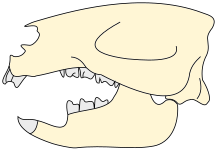| Adalatherium Temporal range: Late Cretaceous (Maastrichtian)
| |
|---|---|

| |
| Restoration of the skull in lateral view | |
| Scientific classification | |
| Domain: | Eukaryota |
| Kingdom: | Animalia |
| Phylum: | Chordata |
| Class: | Mammalia |
| Clade: | †Gondwanatheria |
| Family: | †Adalatheriidae Krause et al, 2020 |
| Genus: | †Adalatherium Krause et al, 2020 |
| Species: | †A. hui
|
| Binomial name | |
| †Adalatherium hui Krause et al, 2020
| |
Adalatherium (Adàla, ‘crazy’ in Malagasy and therium, 'beast' in Greek) is an extinct gondwanatherian that lived on Madagascar during the Maastrichtian stage of the Late Cretaceous.[1] The discovery of the first nearly-complete Adalatherium skeleton from the Maevarano Formation was announced in April 2020.
YouTube Encyclopedic
-
1/3Views:13 539813701
-
Hunter become the Hunted ! | Prehistoric Planet | Masiakasaurus | Madtsoia | Adalatherium
-
Macalester Professor helps discover "Crazy Beast" in Madagascar
-
What is the "Crazy Beast"? Ask A Scientist (Mammal discovery!)
Transcription
Description
Although known fossil is estimated to be subadult individual, it had large skull reaching length 8.4 centimetres (3.3 in), body length about 52 centimetres (20 in)[2] and body mass is estimated between 1.775–5.218 kilograms (3.91–11.50 lb), making it one the largest known Mesozoic mammals only exceeded by fellow Malagasy gondwanathere Vintana, Repenomamus and Patagomaia.[1] It is depicted in reconstructions as being built somewhat like a badger. Its skeleton is the most complete of any Southern Hemisphere Mesozoic mammal. Additionally, the front of the skull contains more foramina than any known mammal except Vincelestes.[3]
References
- ^ a b Krause, David W.; Hoffmann, Simone; Hu, Yaoming; Wible, John R.; Rougier, Guillermo W.; Kirk, E. Christopher; Groenke, Joseph R.; Rogers, Raymond R.; Rossie, James B.; Schultz, Julia A.; Evans, Alistair R. (2020-04-29). "Skeleton of a Cretaceous mammal from Madagascar reflects long-term insularity". Nature. 581 (7809): 421–427. doi:10.1038/s41586-020-2234-8. ISSN 1476-4687. PMID 32461642. S2CID 216650606.
- ^ "Madagascar's prehistoric 'crazy beast' sheds light on mammalian evolution". India Today. Retrieved 2023-05-23.
- ^ Krause, David W.; Hoffmann, Simone; Rossie, James B.; Hu, Yaoming; Wible, John R.; Rougier, Guillermo W.; Kirk, E. Christopher; Groenke, Joseph R. (2020-12-14). "Craniofacial morphology of Adalatherium hui (Mammalia, Gondwanatheria) from the Late Cretaceous of Madagascar". Journal of Vertebrate Paleontology. 40 (sup1): 19–66. doi:10.1080/02724634.2020.1808665. ISSN 0272-4634. S2CID 230968119.


